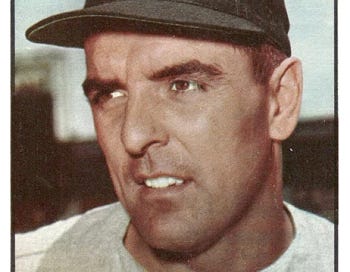Note: When you click on links to various merchants in this newsletter and make a purchase, this can result in this newsletter earning a commission. Affiliate programs and affiliations include, but are not limited to, the eBay Partner Network and Amazon Associates.
1961 Topps Curt Simmons (#11) - Card of the Day
(affiliate link)
Curt Simmons entered Spring Training in 1960 fresh off a lost 1959 season that saw him go 0-0 with a 4.50 ERA in just seven appearances. Oh, and also coming off elbow surgery.
Even so, the year(ish) away from the mound gave his chronically sore left shoulder a chance to rest up, and Simmons felt fresh — “pressing like a kid,” he said.
Things went well enough in the spring that Simmons started the Phillies’ home opener on April 14…and got it up. In one inning, the Milwaukee Braves touched the lefty for three runs (all earned) on a Johnny Logan walk and home runs by Hank Aaron and Joe Adcock.
Simmons made just three more appearances, and only one more start, before the Phils released him and his 18.00 on May 17. Never mind the 115-110, 3.66 ERA he had put up in 1900-plus innings over 13 years with Philadelphia for teams that managed to finish within ten games of first place only twice. One of those, of course, was in 1950, when the Whiz Kids went to the World Series thanks in no small part to Simmons’ 17-8 showing.
No, Simmons was damaged goods, coming off a lost season and seemingly headed for another. He was also within two weeks of his 31st birthday, and the Phillies were rebuilding, so there was little hope the lefty could contribute anything meaningful.
So they just cut him loose.
Meanwhile, the St. Louis Cardinals were struggling to get to .500, just like the Philliess, but the Cards still had designs on competing in the National League. Part of the issue was that their pitching staff was young and largely unproven, with veteran Larry Jackson the lone dedicated starter. Behind him was a group of swing men that included Ernie Broglio, Ron Kline, and Bob Gibson — Gibson and Broglio were just 24.
And, on May 19, Ray Sadecki made his major league debut at just 19.
So the next day, Cardinals general manager Bing Devine took a flyer on Philly’s castoff, signing Simmons as a free agent.
The new acquisition took the ball for St. Louis for the first time two days later, on May 22, holding the Reds scoreless in three innings of relief work. Three more solid bullpen outings led Simmons back to the rotation, and he locked in hard.
He spent the rest of the season with the Cards and pitched like a star — 7-4, 2.66 ERA in 17 starts over 23 total appearances. St. Louis finished in third place in the National League, but Simmons wasn’t going anywhere.
In 1961, when he made his first cardboard Cardinals appearance (see Topps card above), he went just 9-10, but with a 3.13 ERA. Then he reeled off three straight ten-win seasons, including an 18-9, 3.43 ERA showing in 1964 as the Cards won the pennant.
Simmons made two starts in the World Series against the Yankees. Although he went 0-1, he pitched 14.1 strong innings, posting a 2.51 ERA as St. Louis took the title in seven games.
Entering the latter half of his 30s in 1965, Simmons was never quite as sharp again, with ERAs climbing above 4.00 and his innings starting to dwindle. The Cards sold him to the Cubs in 1966, who in turn sold him to the Angels in 1967. He threw his last big league pitch for the Halos on October 1, 1967.,
But, thanks to the Cardinals taking a chance on an “old man,” Simmons added 78 wins to his career tally after leaving the Phillies, while lowering his overall ERA from 3.66 to 3.54. Why Simmons and Frank Robinson weren’t at the forefront of AARP membership drives remains one of baseball’s great mysteries.
The late Curtis Thomas Simmons, old and washed up at 30 but a star at 31 (and 35, for that matter), was born on May 19, 1929.
A Tip of the Cap to The Big Cat
Simmons made his big league debut way back on September 28, 1947, against the NewYork Giants at Shibe Park. He went the distance, striking out nine and giving up a single run as the Phils won, 3-1.
The first batter Simmons faced was slugging first baseman Johnny Mize, also leading off the Giants that afternoon. The Big Cat grounded out to shortstop Granny Hamner to open the game, and went 1-for-5 on the day.
Most of that summer had unfolded much better for Mize, as he led the majors with 51 home runs and 138 RBI, while also scoring 137 runs.
Mize was also sort of a flip-flop version of Simmons, as the slugger spent the first six seasons of his Hall of Fame careers with the Cards. And, like Simmons, he ended up in unfamiliar climes, winning five straight World Series as a first baseman and pinch hitter for the Yankees from 1949 through 1953.
The next year, Red Man Tobacco gave one last cap tip to Mize’s baseball career. Read all about it right here.






FYI, Mick Abel tied Simmons debut record of 9k’s in yesterday’s start.